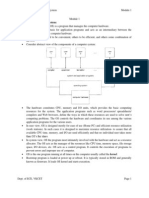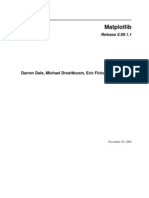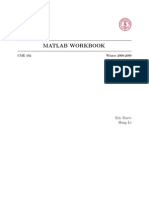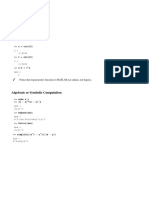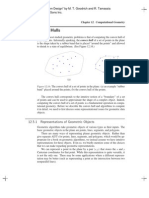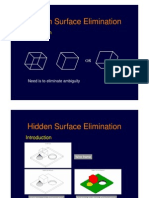Notes Dda Line Drawing Algorithm
Uploaded by
api-263987257Notes Dda Line Drawing Algorithm
Uploaded by
api-263987257DDA Line Drawing Algorithm
Theory:
The DDA (Digital Diferential Analyzer) method is based on taking unit
steps along one of the coordinates (lets say coordinate) and
compute the corresponding !alues along other coordinate ("
coordinate)#
The unit steps taken are always taken along coordinates of greatest
change# $%ample& if we ha!e change in coordinates d%'(( and
change in " coordinates dy') then we would take unit steps along
coordinate and compute the steps along " coordinate#
DDA Working Principal:
DDA generates a line from the diferential e*uation of line&
y = m x + b
+++++++## slope intercept form
where& m is the slope of line and b is its " intercept
m ' dy , d% ' (%-.%() , (y-.y()
++++++ (%(&y() and (%-&y-)
are two end points of line
d% ' %-.%(
+++++## change in coordinates
dy ' y-.y(
+++++## change in " coordinates
/o for any gi!en inter!al (d%)& we can calculate corresponding "
inter!al (dy) as&
dy ' ( (y-.y() , (%-.%() ) 0 (d%) +++##
increment in coordinate
/imilarly for any gi!en " inter!al (dy)& we can calculate corresponding
inter!al (d%) as&
d% ' ( (y-.y() , (%-.%() ) 0 (dy) ++##
increment in " coordinate
1nce he inter!als are known the !alues for ne%t % and y on straight line
can be obtained as follows&
i2(' i2 d%
"i2(' "i2 dy
x2
(x2,y
2)
By- Prof.U.N.Abhonkar,Sandip Polytechnic
Y
dy
y2
x1
(x1,y1
)
d
%
y1
DDA ine Dra!ing Algori"hm:
Step 1: Read line end points !1 ,y1" and !#,y#" s$ch that they
are not e%$al
if they are e%$al plot the point and end the al&orithm"
Step #: 'alc$late,
d! ( )!# * !1)
dy ( )y# * y1)
Step +: ,f d!" - ( dy" then
.en&th ( d!
else
.en&th ( dy
/nd if
Step 0: 1increment ( !#-!1" 2 len&th
3increment ( y#-y1" 2 len&th
Step 4: ! ( !15 6.4 7 si&nd!"
y ( y15 6.4 7 si&ndy"
8ere si&n f$nction makes al&orithm 9orks in all %$adrants
ret$rns -1, 6, 1 9hen
Ar&$ment is :6, (6, -6 resp. "
Step ;: i ( 1
9hile i : ( len&th "
<
p$tpi!el ! , y , =8,>/ "
! ( ! 5 1increment
y ( y 5 3increment
i ( i5 1
?
Step @: Stop
A#$an"age% o& DDA ine Dra!ing Algori"hm:
3aster than direct use of line e*uation and it does not do any 4oating
point multiplication
/imple to implement
By- Prof.U.N.Abhonkar,Sandip Polytechnic
'
((),
))
Di%a#$an"age% o& DDA ine Dra!ing Algori"hm:
Time consuming arithmetic because 4oating point addition is still
needed
5recision loss because of rounding of error
5i%els drift farther apart if line is relati!ely large
* co#e &or DDA ine Dra!ing Algori"hm:
22 AAA .ine Ara9in& Al&orithm
Bincl$de:stdio.h-
Bincl$de:conio.h-
Bincl$de:math.h-
Bincl$de:&raphics.h-
Coid main"
<
Coid ddalineint,int,int,int"D
int &d(A/>/'>,&mD
int p1,%1,p#,%#D
clrscr"D
init&raph E&d,E&m,F':GG>'GGBH,F"D
printfF/nter the co-ordinates of the Irst point GnF"D
printfF!1( F"D
scanfFJd F,Ep1"D
printfFy1( F"D
scanfFJd F,E%1"D
printfF/nter the co-ordinates of the second point GnF"D
printfF!#( F"D
scanfFJd F,Ep#"D
printfFy#( F"D
scanfFJd F,E%#"D
ddalinep1,%1,p#,%#"D
&etch"D
By- Prof.U.N.Abhonkar,Sandip Polytechnic
close&raph"D
?
Coid ddalineint !1,int y1,int !#,int y#"
<
int d!,dy,len&th,iD
Koat !inc,yinc,!,yD
d!( !#-!1D
dy( y#-y1D
if absd!" - absdy""
len&th ( absd!"D
else
len&th ( absdy"D
!inc ( Koat" d!2 len&thD
yinc ( Koat" dy2 len&thD
! ( !1D
y ( y1D
i ( 1D
9hile i : len&th"
<
p$tpi!el !,y,B.U/"D
! ( ! 5 !incD
y ( y 5 yincD
i 55 D
?
?
By- Prof.U.N.Abhonkar,Sandip Polytechnic
You might also like
- Unit I J Line Drawing Algorithm - DDA Algorithm, Unit I K Bresenham's AlgorithmNo ratings yetUnit I J Line Drawing Algorithm - DDA Algorithm, Unit I K Bresenham's Algorithm22 pages
- Bresenham Line Drawing Algorithm For Negative Slope Examples PDFNo ratings yetBresenham Line Drawing Algorithm For Negative Slope Examples PDF4 pages
- Using Macromedia Flash MX Workshop NotesNo ratings yetUsing Macromedia Flash MX Workshop Notes25 pages
- Matrix Inversion in Matlab - Gauss-Jordan MethodNo ratings yetMatrix Inversion in Matlab - Gauss-Jordan Method3 pages
- Eight Way Symmetry: Midpoint Line Drawing AlgorithmNo ratings yetEight Way Symmetry: Midpoint Line Drawing Algorithm20 pages
- Trigonometry Formulas and Properties: Updated: October 2019No ratings yetTrigonometry Formulas and Properties: Updated: October 20192 pages
- CGPresentation Week6 (MidpointLine&Circle)No ratings yetCGPresentation Week6 (MidpointLine&Circle)62 pages
- Chapter 3 Vectors in 2-Space and 3-SpaceNo ratings yetChapter 3 Vectors in 2-Space and 3-Space68 pages
- A Workbook On Implementing L-System Fractals Using PythonNo ratings yetA Workbook On Implementing L-System Fractals Using Python9 pages
- 5 L L EC533: Digital Signal Processing: DFT and FFTNo ratings yet5 L L EC533: Digital Signal Processing: DFT and FFT20 pages
- Lecture 9 - Discrete Fourier Transform and Fast Fourier Transform (I)No ratings yetLecture 9 - Discrete Fourier Transform and Fast Fourier Transform (I)19 pages
- Advances in Computers, Vol.58.. Highly Dependable Software (AP, 2003) (ISBN 9780120121588) (O) (373s) - CsAlNo ratings yetAdvances in Computers, Vol.58.. Highly Dependable Software (AP, 2003) (ISBN 9780120121588) (O) (373s) - CsAl373 pages
- Microprocessors MCQs Set-4 ExamRadar PDFNo ratings yetMicroprocessors MCQs Set-4 ExamRadar PDF3 pages
- program To Draw A Line Using Mid Point AlgorithmNo ratings yetprogram To Draw A Line Using Mid Point Algorithm2 pages
- Introduction To Programming and Algorithms Cat 2100% (1)Introduction To Programming and Algorithms Cat 210 pages
- Exam - Applied Mathematics I, December 26, 2004.100% (1)Exam - Applied Mathematics I, December 26, 2004.6 pages
- DDA & Bresenham's Line Drawing AlgorithmNo ratings yetDDA & Bresenham's Line Drawing Algorithm8 pages
- 025aad1bec9bd-Assignment - Vector CalculusNo ratings yet025aad1bec9bd-Assignment - Vector Calculus18 pages
- Matlab Workbook: CME 102 Winter 2008-2009No ratings yetMatlab Workbook: CME 102 Winter 2008-200955 pages
- Asymptotic Notation, Review of Functions & Summations100% (1)Asymptotic Notation, Review of Functions & Summations45 pages
- Bresenhams Line Generation Algorithm: FunctionNo ratings yetBresenhams Line Generation Algorithm: Function8 pages
- Digital Differential Analyser: Basic Line DDANo ratings yetDigital Differential Analyser: Basic Line DDA23 pages
- p5 Notes Flood Fill Algorithm For Polygon FillingNo ratings yetp5 Notes Flood Fill Algorithm For Polygon Filling3 pages
- Geometric Modeling and Associated With Computational GeometryNo ratings yetGeometric Modeling and Associated With Computational Geometry8 pages
- #Include #Include #Include #Include #Include #Include #Include #Include #Include #Include #Include #Include #Include #Include #Include #Include #Include #Include #Include #Include Class PublicNo ratings yet#Include #Include #Include #Include #Include #Include #Include #Include #Include #Include #Include #Include #Include #Include #Include #Include #Include #Include #Include #Include Class Public3 pages
- Precise 24-Week HFT C++ and Codeforces 2000+ RatingNo ratings yetPrecise 24-Week HFT C++ and Codeforces 2000+ Rating23 pages
- Computer Graphics Polygon Clipping: by Asmita NagNo ratings yetComputer Graphics Polygon Clipping: by Asmita Nag26 pages
- PDF Geometry for Programmers, MEAP Version 3 Oleksandr Kaleniuk download100% (1)PDF Geometry for Programmers, MEAP Version 3 Oleksandr Kaleniuk download65 pages
- Geometric Data Structures For Computer Graphics: Gabriel Zachmann & Elmar LangetepeNo ratings yetGeometric Data Structures For Computer Graphics: Gabriel Zachmann & Elmar Langetepe54 pages
- Geometric Modeling - Explicit - Implicit RepresentationsNo ratings yetGeometric Modeling - Explicit - Implicit Representations56 pages
- Computational Geometry With The Rotating Calipers PDFNo ratings yetComputational Geometry With The Rotating Calipers PDF133 pages
- Computation Geometry Algorithms Library From CGALNo ratings yetComputation Geometry Algorithms Library From CGAL27 pages
- Computer Graphics - Hidden Surface Elimination100% (1)Computer Graphics - Hidden Surface Elimination68 pages
- Quantum Computation in Computational GeometryNo ratings yetQuantum Computation in Computational Geometry8 pages
- Cad/Cam Unit 2 UO4 Solid Modeling-Constructive Solid GeometryNo ratings yetCad/Cam Unit 2 UO4 Solid Modeling-Constructive Solid Geometry8 pages












